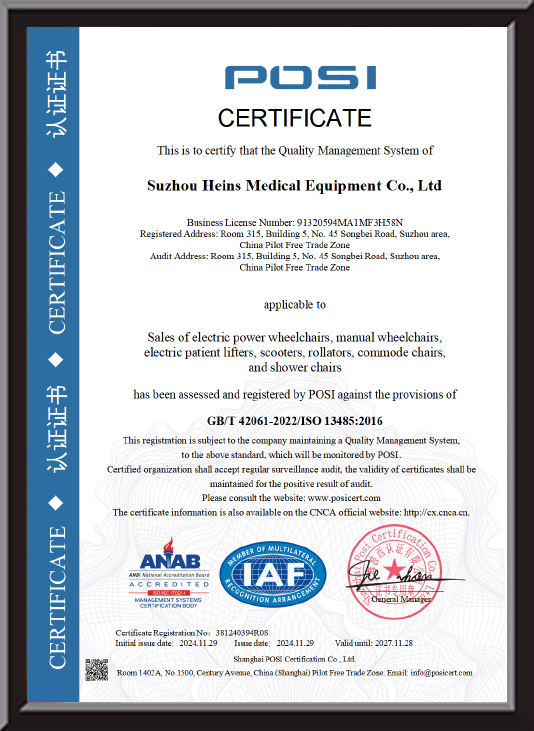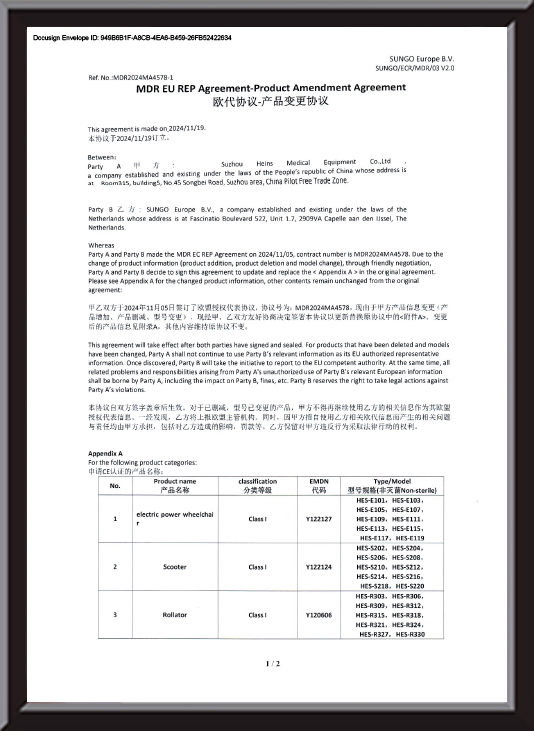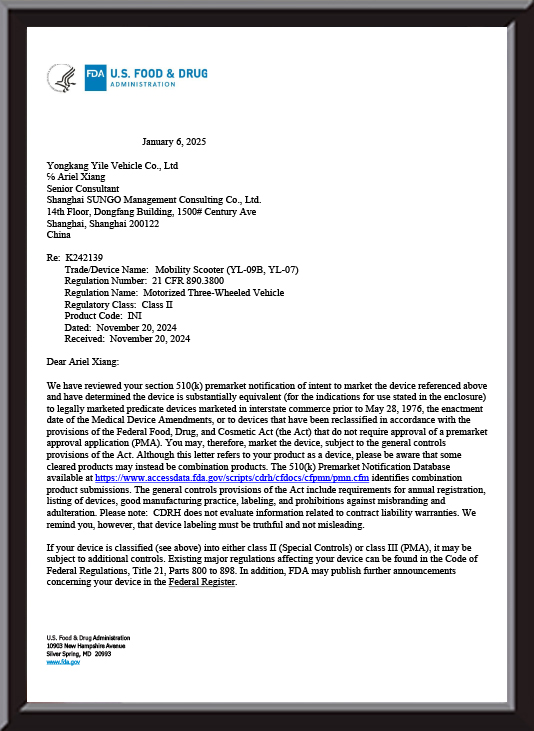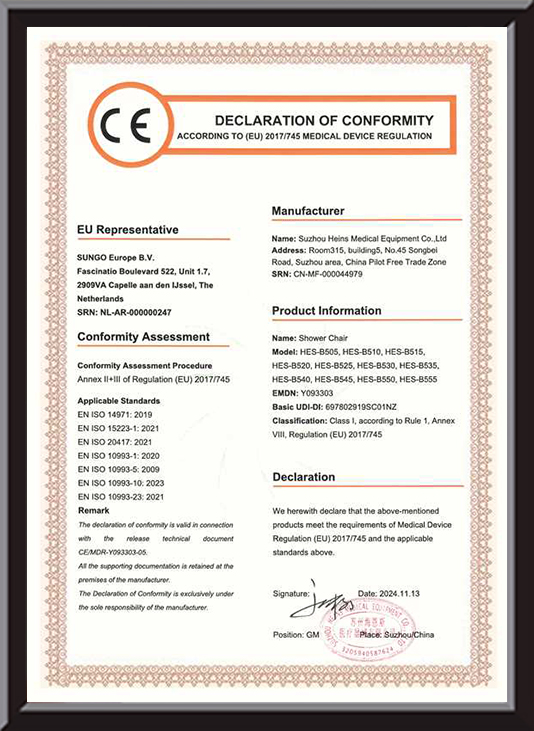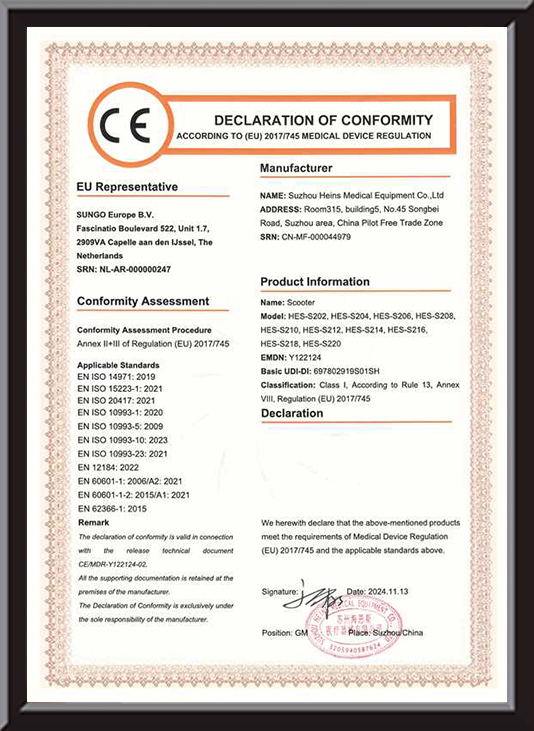-
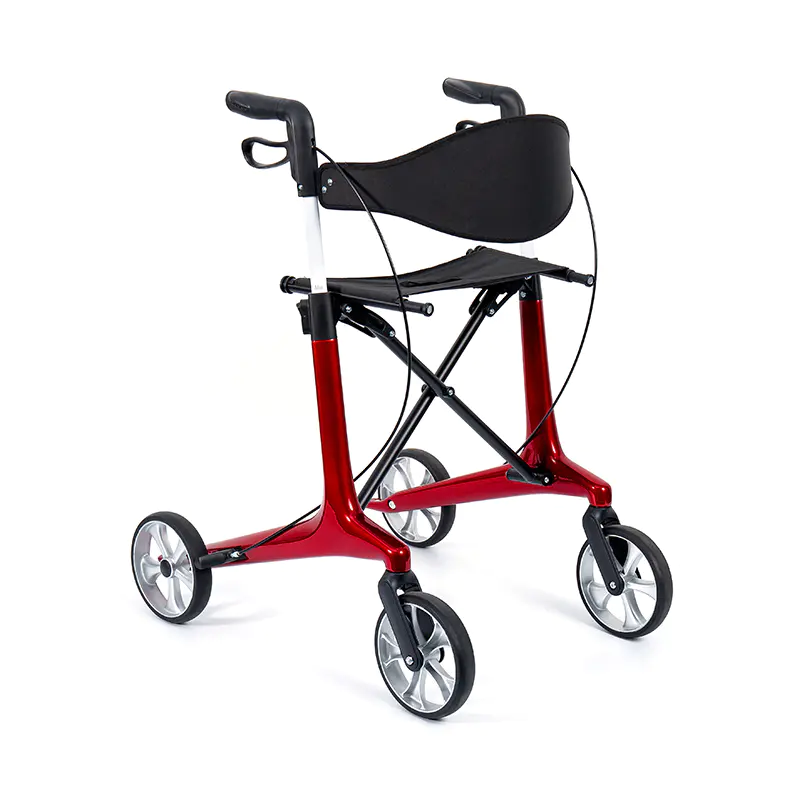 HES- R306VIEW MORE HES-R306 Lightweight Rollator – Foldable, TPR Wheels, Adjustable, 150kg Weight Capacity Product Description: 7-Level Height Adjustment: Customize the handlebar height for optimal posture a...
HES- R306VIEW MORE HES-R306 Lightweight Rollator – Foldable, TPR Wheels, Adjustable, 150kg Weight Capacity Product Description: 7-Level Height Adjustment: Customize the handlebar height for optimal posture a... -
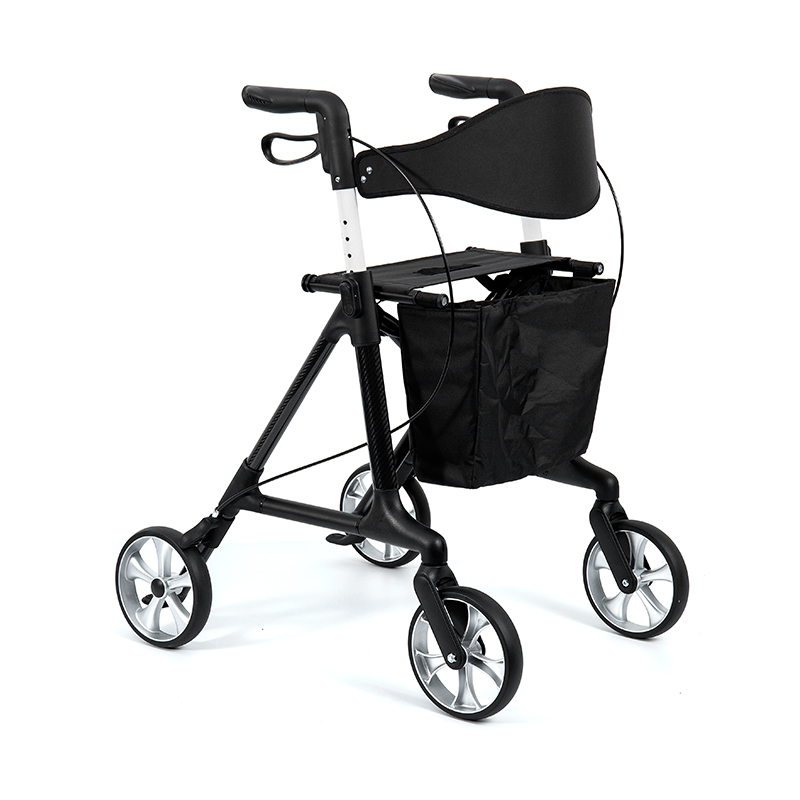 HES-R321VIEW MORE HES-R321 Premium Carbon Fiber Rollator Product Description: 7-Level Height Adjustment System: Customizable handlebar positions (78-98m rang...
HES-R321VIEW MORE HES-R321 Premium Carbon Fiber Rollator Product Description: 7-Level Height Adjustment System: Customizable handlebar positions (78-98m rang... -
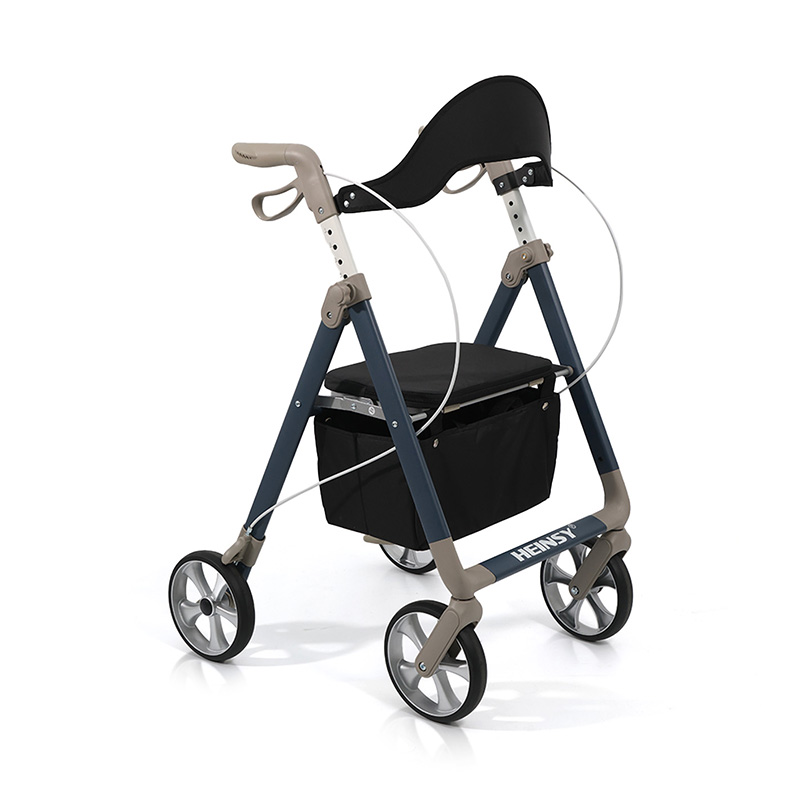 HES- R318VIEW MORE HES-R318 Comfort Rollator for Seniors Product Description:7-Level Height Adjustment System: Customizable handlebar positions, tool-free ad...
HES- R318VIEW MORE HES-R318 Comfort Rollator for Seniors Product Description:7-Level Height Adjustment System: Customizable handlebar positions, tool-free ad...
Custom Foldable Rollator Walker Manufacturers
-
Amid accelerating population aging and increasingly refined rehabilitation needs, the demand for safe, adaptable, and user-friendly assistive equipme...
READ MORE -
The foldable electric mobility scooter has become an essential tool for many individuals seeking convenient, efficient, and independent transportation...
READ MORE -
The Powerful Motor Scooter has become an increasingly popular choice among mobility device users who value efficiency, stability, and independence. Co...
READ MORE -
Heins Medical to Showcase a Diverse Range of Rehabilitation Aids atRussian Health Care Week 2025Exploring New Opportunities for International Collabor...
READ MORE -
The landscape of patient care is undergoing a significant shift. For decades, complex medical equipment was largely confined to acute care settings, w...
READ MORE
Can Cost-Effective Foldable Rollator Walker for Seniors focus on durability while taking into account cost-effectiveness?
Material Innovation: The cornerstone of balancing cost and durability
The choice of materials directly determines the durability and cost of the Cost-Effective Foldable Rollator Walker for Seniors. In terms of metal materials, some companies use high-strength aluminum alloys to replace traditional steel, such as Suzhou Heins Medical Equipment Co., Ltd., which is committed to the research and development and production of high-quality mobile auxiliary products for the elderly. When designing folding walkers, they use lightweight but sturdy aluminum alloys. The density of aluminum alloy is only one-third of that of steel, but it can achieve similar strength, which not only makes the walker lighter and easier for the elderly to operate and carry, but also reduces transportation costs, which in turn affects the final selling price of the product. At the same time, aluminum alloy has good corrosion resistance and is not prone to rust even if exposed to humid environments for a long time, which greatly extends the service life of the product.
Engineering plastics also play an important role in the application of non-metallic materials. The handles, foot pedals and other components of some walkers are made of special engineering plastics. This type of material has the characteristics of wear and impact resistance, and has relatively low production costs. By scientifically combining metal with non-metallic materials, while ensuring the solid and durable core structure of the walker, the overall cost is reasonably controlled, and the preliminary balance between cost-effectiveness and durability is achieved.
Design optimization: Improve durability and user experience
The integration of modern industrial design concepts has enabled Cost-Effective Foldable Rollator Walker for Seniors to achieve a double breakthrough in durability and practicality. The innovative design of the folding structure is particularly critical. The new generation of walkers adopts a double-lock linkage system and is combined with the aviation-grade stainless steel spring hinge. After 5,000 folding tests, the opening and closing resistance change rate is still less than 5%. The operation process is simplified to 3 steps, taking no more than 10 seconds, which not only reduces component wear and extends the replacement cycle of key components to 3-5 years. This precision design not only reduces maintenance costs, but also increases the long-term use value of the product by reducing the risk of accidental failures.
The in-depth application of ergonomics further enhances product durability. The handle that conforms to the human body curve is wrapped with TPE thermoplastic elastomer, with a surface friction coefficient of 0.8, effectively preventing damage to parts caused by hand loss. The radian of the handle is optimized based on the hand joint movement data of the elderly, which can reduce wrist pressure by 40% and reduce structural losses caused by posture errors. The adjustable height handrail system supports 10-speed adjustment, covering the height range of 80-100cm, adapted to users of different heights to avoid component deformation caused by forced use. These design details not only improve the user experience, but also indirectly extend the service life of the walker by reducing abnormal stress.
Large-scale production and quality control: Reduce costs while ensuring quality
The popularization of intelligent manufacturing and large-scale production models has completely changed the cost structure of Cost-Effective Foldable Rollator Walker for Seniors. Industry data shows that through centralized procurement strategies, leading manufacturers can reduce the cost of aluminum alloy raw materials by 12% and the cost of engineering plastics by 18%. The introduction of automated production lines significantly improves production efficiency, with a single product production cycle compressing from 4 hours to 2.5 hours, and labor costs decreased by 25%. The superimposed scale effect and technological upgrades reduce the production cost per unit product by 20%-25%, providing price competitiveness for the terminal market.
The improvement of the quality control system is an important guarantee for both cost-effectiveness and durability. Strict compliance with international standards, such as ISO 13485 Medical Device Quality Management System and EN 12184:2012 European Walker Standard, ensures consistency in product quality. Each walker must pass 12 rigorous testing processes, including load-bearing tests that simulate a 200kg pressure for 24 hours, impact resistance tests that freely fall at a height of 1 meter, and wheel durability tests that simulate 100 kilometers of driving on different roads. This full-process quality monitoring reduces the product failure rate to below 50% of the industry average, achieving a balance between cost control and quality assurance.
Market competition and technological iteration: promoting the improvement of cost-effectiveness and durability
Fierce market competition has prompted companies to accelerate technological innovation and inject new performance advantages into Cost-Effective Foldable Rollator Walker for Seniors. The application of intelligent sensing technology has significantly improved product safety and durability. The MEMS microelectromechanical system sensor can monitor key parameters such as wheel wear and loose structure in real time. When the wheel wears more than 2mm or when the parts are detected to be loose, the system immediately triggers the acoustic and light alarm and locks the folding mechanism to prevent accidents. Actual application data shows that the walker equipped with an intelligent monitoring system has reduced the fault repair rate by 35%, greatly reducing long-term maintenance costs.
The combination of 3D printing and topological optimization technology has brought revolutionary changes to product research and development. Enterprises quickly produce parts prototypes through 3D printing, shortening the R&D cycle of new products from 6 months to 3 months, and reducing R&D costs by 40%. The topology optimization algorithm uses computer simulation to design the components lightweight while ensuring structural strength, further reducing material costs. In addition, the introduction of IoT technology has enabled travellers to have remote diagnosis functions, and manufacturers can predict potential failures in advance through data analysis, provide preventive maintenance suggestions, and extend product life cycle.
Future Trends: The Integration of Intelligence and Sustainability
With the upgrading of the elderly consumer market, the development of Cost-Effective Foldable Rollator Walker for Seniors has shown a trend of intelligence and sustainability. The application of artificial intelligence technology enables walkers to automatically adjust the assist mode by learning user behavior habits through machine learning, improving the convenience of use while reducing component losses. At the environmental level, the wide application of recyclable materials and modular design concepts not only reduce production costs, but also enable more than 70% of components to be reusable after the end of the product life cycle. These innovative directions indicate that in the future, the walker will achieve higher-level technological breakthroughs in the balance of cost-effectiveness and durability.
Cost-Effective Foldable Rollator Walker for Seniors has successfully achieved an organic combination of cost-effectiveness and durability through material innovation, design optimization, production model upgrade and technical iteration. With the continuous advancement of technology and the deepening of market demand, such products will provide long-term and reliable services at a more economical cost while ensuring the safety of the elderly’s travel, becoming the core solution in the field of assisted mobile devices for the elderly.



 Español
Español Deutsch
Deutsch عربى
عربى
